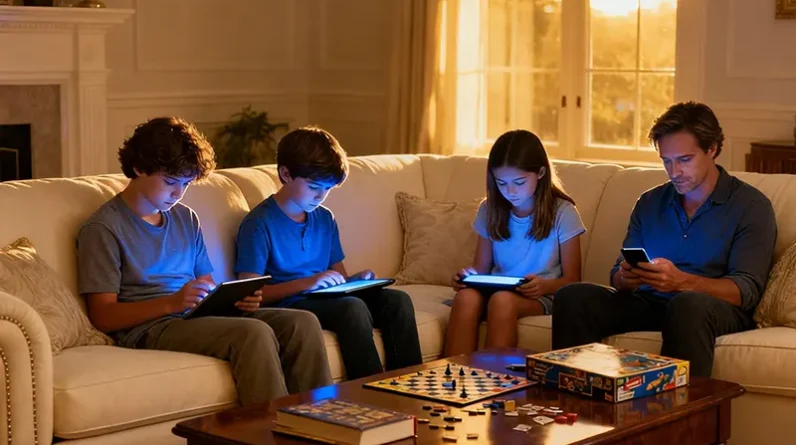
When screens become sources of family stress rather than connection, we can reset by recognizing warning signs like increased irritability, sleep disruption, and strained conversations. We’ll need to establish both physical boundaries—creating device-free bedrooms and dining areas—and temporal limits through structured schedules. As parents, we must model the respectful technology use we want to see, since children learn more from observation than lectures. Building engaging alternatives like board games and outdoor adventures helps naturally replace excessive screen time while meeting our children’s developmental needs for connection and stimulation.
Recognizing the Warning Signs of Digital Overwhelm in Your Family
Digital overwhelm manifests differently across family members, but the signs often appear gradually before becoming impossible to ignore. We might notice increased irritability when devices are put away, declining academic performance, or physical symptoms like headaches and sleep disruption. Family dynamics shift as conversations become strained and shared activities decrease. Children may exhibit withdrawal from previously enjoyed offline pursuits, while parents find themselves constantly negotiating screen time battles.
The shift from healthy technology use to digital addiction occurs along a spectrum. We can identify concerning patterns when family members struggle to self-regulate usage, experience anxiety without devices, or prioritize screen time over relationships and responsibilities. These behavioral changes signal that our family’s relationship with technology requires immediate attention and intentional restructuring.
Creating Physical and Temporal Boundaries for Screen Use
Boundaries serve as the foundation for healthy technology habits, requiring us to establish clear rules about when and where screens can be used within our homes. Physical boundaries transform our living spaces into intentional zones—bedrooms become screen-free sanctuaries, dining tables return to conversation hubs, and designated device parking stations create visual reminders of our commitment to balance.
Temporal boundaries prove equally powerful. We can implement screen limits through structured schedules: no devices during the first hour after waking, mandatory breaks every 45 minutes, and complete digital detox periods on weekends. These time-based restrictions help our brains develop healthier dopamine patterns while strengthening our capacity for sustained attention. When we consistently enforce both physical and temporal boundaries, we create predictable rhythms that support our family’s emotional regulation and cognitive development.
Establishing Device-Free Zones and Sacred Family Times
The most profound family connections often emerge in spaces where screens can’t compete for our attention. Creating device-free zones requires intentional design—designating bedrooms, dining areas, or family rooms as technology-free sanctuaries where authentic interaction flourishes.
Sacred family times function as protective rhythms that prioritize human connection. Whether it’s device-free dinners, weekend morning rituals, or bedtime routines, these boundaries create predictable spaces for meaningful engagement. Research demonstrates that families practicing consistent screen-free periods report improved communication quality and reduced conflict.
Effective device etiquette emerges when we model respectful technology use ourselves. Children internalize boundaries through observation, not lectures. When we consistently honor these sacred spaces and times, we’re teaching essential life skills while nurturing family harmony that extends far beyond childhood.
Modeling Healthy Digital Habits as Parents
Children absorb our digital behaviors like sponges, making our own relationship with technology the most powerful teaching tool we possess. Digital parenting starts with honest self-reflection about our screen habits and their impact on family dynamics.
| Instead of This | Model This |
|---|---|
| Scrolling during conversations | Active listening with devices away |
| Checking phones at meals | Engaging in meaningful dialogue |
| Working late on devices | Setting clear work boundaries |
We become healthy rolemodels when we demonstrate intentional technology use. This means narrating our digital choices: “I’m putting my phone in the kitchen drawer so we can focus on our game.” Research shows children whose parents practice mindful device use develop stronger self-regulation skills. Our consistent modeling creates the foundation for lifelong healthy digital habits.
Building Alternative Activities That Naturally Replace Screen Time
While modeling healthy digital habits sets the foundation, we can’t simply remove screens without offering compelling alternatives. Children naturally gravitate toward activities that provide immediate engagement and social connection—the same elements that make devices so appealing.
Board games offer structured interaction that builds executive function skills while creating shared experiences. Research shows these activities strengthen family bonds and develop critical thinking abilities that transfer to academic performance.
Outdoor adventures tap into children’s innate curiosity and physical energy needs. Whether it’s nature scavenger hunts or backyard obstacle courses, these experiences provide sensory richness that screens can’t replicate.
The key is identifying what specific needs screens currently meet—entertainment, social connection, or stimulation—then intentionally designing alternatives that fulfill those same developmental requirements more effectively.
Conclusion
Like tending a garden, we can’t simply pull weeds once and expect lasting results. Resetting our family’s digital boundaries requires ongoing attention, patience, and gentle cultivation. When we recognize the warning signs early, establish clear boundaries, and model healthy habits ourselves, we’re planting seeds for a more balanced future. Remember, small consistent changes create lasting transformation. Our children are watching how we navigate this digital world—let’s show them the way forward together.







